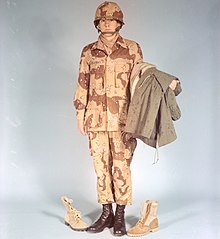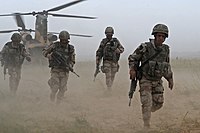Desert Battle Dress Uniform
This article needs additional citations for verification. (January 2013) |
| Desert Battle Dress Uniform | |
|---|---|
 Closeup of Desert Battle Dress Uniform (DBDU) | |
| Type | Military camouflage pattern |
| Service history | |
| In service | 1981–1995 (U.S. military) |
| Used by | See Users for other foreign military/law enforcement users |
| Wars | Persian Gulf War Somali Civil War Iraq War Libyan civil war (2011) |
| Production history | |
| Designer | U.S. Army Soldier Systems Center |
| Designed | 1970 |
The Desert Battle Dress Uniform (DBDU)[1] is a U.S. arid-environment camouflage battle uniform that was used by the United States Armed Forces from the early 1980s to the early to mid 1990s, most notably during the Persian Gulf War. Although the U.S. military has long since abandoned the pattern, it is still in widespread use by militaries across the world as of the early 2020s.
Appearance


The Desert Battle Dress Uniform was designed in 1970[2] and uses a camouflage pattern known as the Six-Color Desert Pattern or colloquially as Chocolate-Chip Camouflage and Cookie Dough Camouflage. The camouflage received its nickname because it resembles chocolate-chip cookie dough. It is made up of a base pattern of light tan overlaid with broad swathes of pale green and wide two-tone bands of brown. Clusters of black and white spots are scattered over, to mimic the appearance of pebbles and their shadows.
History

Although the chocolate-chip camouflage became well known during the
U.S. Army
With limited issuing dating back to
U.S. Marine Corps
Like the Army, the DBDU was seldom issued whenever Marines were deployed to participate in the "Bright Star" exercises, but became their standard arid combat uniform by 1985. The 6-color desert pattern was used by the U.S. Marine Corps from 1982 to 1995.
U.S. Air Force
First issued in 1982 for their participation and deployments to arid regions, the DBDU became the United States Air Forces primary desert uniform from 1982 to 1993.
Like its sister branches, The Navy began limited issue of the DBDU in the early 80s and became standard wide by 1985. It would remain the Navy's main desert combat uniform from the early '80s to the mid '90s.
U.S. Coast Guard
The Coast Guard was the last branch to see remaining issue of the DBDU in the mid to late 1980s.
Operational use
The six-color desert pattern entered service in 1981 at the same time as the
The pattern was unpopular with American soldiers during the Gulf War.
Replacement
An initial batch of desert BDUs in the new camouflage scheme was en route to the Middle East when hostilities ceased.[5] The pattern, officially issued with the newer Desert Camouflage Uniform (DCU) in the early 1990s, consisted of a subtle blend of large pastel green and light tan shapes, with sparsely placed, narrow, reddish brown patches, leading the design to be unofficially nicknamed the “Coffee Stain” pattern.
Both patterns were briefly used together during the transition period, most notably during
Legacy

As of the early 2010s, the chocolate-chip pattern is still in widespread use across the world, long after the United States abandoned it. A uniform similar to the Desert Battle Dress Uniform was issued to the
Users
This section needs additional citations for verification. (September 2017) |
 Argentina
Argentina Bolivia
Bolivia Brazil
Brazil Chad
Chad China: Made own camos based on DBDU fabric.[7]
China: Made own camos based on DBDU fabric.[7] Djibouti
Djibouti Dominican Republic
Dominican Republic Egypt: Made own camos based on DBDU fabric.[7]
Egypt: Made own camos based on DBDU fabric.[7] El Salvador
El Salvador Eritrea: Made own camos based on DBDU fabric.[7]
Eritrea: Made own camos based on DBDU fabric.[7] Estonia
Estonia Ethiopia
Ethiopia Al-Qassam Brigades.[8]
Al-Qassam Brigades.[8] Iran: Had used localized DBDU pattern.[9]
Iran: Had used localized DBDU pattern.[9] Iraq: Formerly used by the reformed Iraqi military,[10][11] before being succeeded by the Desert Camouflage Uniform.
Iraq: Formerly used by the reformed Iraqi military,[10][11] before being succeeded by the Desert Camouflage Uniform. Ireland: Used by Irish troops during peacekeeping operations in Somalia in 1993.[12]
Ireland: Used by Irish troops during peacekeeping operations in Somalia in 1993.[12] Israel: Used by Israeli military in unofficial capacity.[13]
Israel: Used by Israeli military in unofficial capacity.[13] Japan
Japan Jordan
Jordan Kazakhstan
Kazakhstan Kuwait: Had used localized DBDU pattern.[9]
Kuwait: Had used localized DBDU pattern.[9] Libya
Libya Mali
Mali Mexico
Mexico Niger
Niger Oman
Oman Pakistan: Made own camos based on DBDU fabric.[7]
Pakistan: Made own camos based on DBDU fabric.[7] Palestine
Palestine Paraguay[9]
Paraguay[9] Peru[9]
Peru[9] Philippines
Philippines Rwanda
Rwanda Saudi Arabia: Grey version used by the Saudi Border Guard forces and King Fahd college students.[14][15][16] Six-colored version also used.[17]
Saudi Arabia: Grey version used by the Saudi Border Guard forces and King Fahd college students.[14][15][16] Six-colored version also used.[17] Somalia: Used by Naval infantry troops and Coastguard[18]
Somalia: Used by Naval infantry troops and Coastguard[18] War in Afghanistan
War in Afghanistan Spain: Made own camos based on DBDU fabric. Replaced by Pixelado árido.[7]
Spain: Made own camos based on DBDU fabric. Replaced by Pixelado árido.[7] Sudan
Sudan Syria
Syria Tajikistan
Tajikistan Thailand
Thailand United Arab Emirates
United Arab Emirates United States: Former standard camouflage uniform pattern from 1981 to 1995
United States: Former standard camouflage uniform pattern from 1981 to 1995
 Yemen
Yemen
-
DBDU-clad Spanish soldiers disembark from a CH-47 Chinook helicopter in Afghanistan, September 2008
-
U.S. PresidentMogadishu Airportin January 1993
-
PakistanAfghan Border Police soldier (right), wearing the Saudi blue DBDUs, guard the Durand Line's Friendship Gate, seven km southeast of Spin Boldak, Afghanistan
-
A DBDU-wearing Pakistani Ranger (Sindh) on duty
See also
References
- ^ United States Army (February 3, 2005). "Army Regulation 670-1: Wear and Appearance of Army Uniforms and Insignia" (PDF). United States Department of Defense. Archived from the original (PDF) on April 28, 2005. Retrieved April 28, 2005.
- ^ "Uniform, desert".
- ^ "Show whips off the camouflage net". BBC News. 2007-03-23. Retrieved 2021-03-27.
- ^ Kearny, Cresson H. (Maj), Jungle Snafus...And Remedies, Oregon Institute of Science and Medicine (1996), pp. 212–213
- ISBN 0-9543404-0-X.
- ^ "DBDU Helmet".
- ^ a b c d e "Little Known Facts and History about Camouflage of the Western World". 2 March 2016.
- ^ "The Son of Al-Qassam". Al-Qassam Brigades Information Office.
- ^ a b c d Dougherty (2017), p. 82.
- ^ "Jacket, Desert 'Chocolate Chip' camouflage (US DBDU): Iraqi".
- ^ "Immediate Post Saddam Iraqi Chocolate Chip Camo Uniform - Middle East Militaria". www.middleeastmilitaria.com. Archived from the original on 2018-08-10.
- ^ Larson (2021), p. 396.
- ^ Larson (2021), p. 255.
- ^ "Saudi King Fahd Grey Chocolate Chip Camo".
- ^ "Saudi Grey Chocolate Chip Uniforms; an Analysis".
- ^ "Saudi Border Guard Chocolate Chip Camo".
- ^ "Saudi Security Forces 6 Color Uniforms".
- ^ "EU Naval Force Supports EUCAP Nestor Led Training Course for Somali Coastguard and Port Police in Djibouti | Eunavfor". eunavfor.eu. Archived from the original on 2014-12-09.
Bibliography
- Dougherty, Martin (2017). Camouflage at War: An Illustrated Guide from 1914 to the Present Day. London, UK: Amber Books. ISBN 978-1782744986.
- Larson, Eric H. (2021). Camouflage: International Ground Force Patterns, 1946–2017. Barnsley: Pen & Sword. ISBN 9781526739537.




